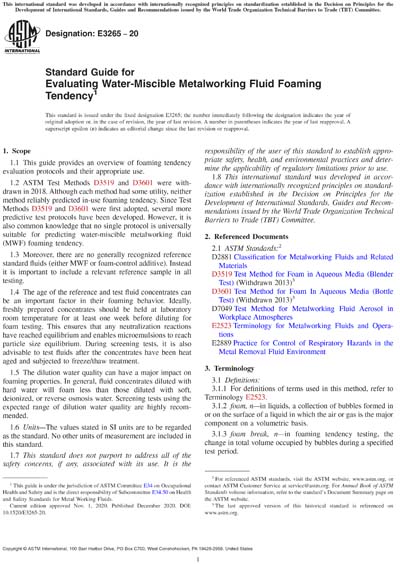Historical
ASTM E3265-20
Standard Guide for Evaluating Water-Miscible Metalworking Fluid Foaming Tendency
1.1 This guide provides an overview of foaming tendency evaluation protocols and their appropriate use.
1.2 ASTM Test Methods D3519 and D3601 were withdrawn in 2018. Although each method had some utility, neither method reliably predicted in-use foaming tendency. Since Test Methods D3519 and D3601 were first adopted, several more predictive test protocols have been developed. However, it is also common knowledge that no single protocol is universally suitable for predicting water-miscible metalworking fluid (MWF) foaming tendency.
1.3 Moreover, there are no generally recognized reference standard fluids (either MWF or foam-control additive). Instead it is important to include a relevant reference sample in all testing.
1.4 The age of the reference and test fluid concentrates can be an important factor in their foaming behavior. Ideally, freshly prepared concentrates should be held at laboratory room temperature for at least one week before diluting for foam testing. This ensures that any neutralization reactions have reached equilibrium and enables microemulsions to reach particle size equilibrium. During screening tests, it is also advisable to test fluids after the concentrates have been heat aged and subjected to freeze/thaw treatment.
1.5 The dilution water quality can have a major impact on foaming properties. In general, fluid concentrates diluted with hard water will foam less than those diluted with soft, deionized, or reverse osmosis water. Screening tests using the expected range of dilution water quality are highly recommended.
1.6 Units—The values stated in SI units are to be regarded as the standard. No other units of measurement are included in this standard.
1.7 This standard does not purport to address all of the safety concerns, if any, associated with its use. It is the responsibility of the user of this standard to establish appropriate safety, health, and environmental practices and determine the applicability of regulatory limitations prior to use.
1.8 This international standard was developed in accordance with internationally recognized principles on standardization established in the Decision on Principles for the Development of International Standards, Guides and Recommendations issued by the World Trade Organization Technical Barriers to Trade (TBT) Committee.
ASTM International [astm]

